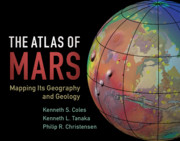Atlas of Venus
Venus, closest planet to the Earth, is a torrid world of extremes shrouded from direct view by dense clouds. This Atlas of Venus shows all the fascinating detail discovered on the recent Magellan mission to map the planet surface. Giving the historical background to our perception of the planet, this book clearly explains why Venus has been the goal of so many missions by both Russian and American space programmes. With the latest images from the Magellan mission, this colourful Atlas shows the beautiful landscape of Venus and its dynamic volcanism. Over 100 maps and illustrations show the dramatic beauty of this photogenic planet. Complete with detailed maps of the planet and a gazetteer of all landmarks, this is the essential reference source for all professional and amateur astronomers, and planetary scientists interested in our closest neighbour.
- Contains the most recent maps from the Magellan space mission
- Contains over 100 maps and illustrations
- Venus is our closest neighbour and the planet that most closely resembles Earth
Reviews & endorsements
"Books on Venus have been either too technical or purely popular. Peter Cattermole and Patrick Moore have bridged the gap between these extremes with Atlas of Venus... an erudite and detailed book, eminently readable and superbly illustrated." David Hughes, New Scientist
Product details
May 1997Hardback
9780521496520
159 pages
287 × 228 × 20 mm
0.95kg
70 b/w illus. 20 colour illus. 1 table
Unavailable - out of print April 2013
Table of Contents
- 1. Venus in the Solar System
- 2. Venus through the telescope
- 3. Before the Space Age
- 4. Missions to Venus
- 5. Mapping Venus
- 6. The Magellan mission
- 7. The Venusian plains - I
- 8. The Venusian plains - II
- 9. Impact craters on Venus
- 10. The highland massifs
- 11. The history of Venus
- 12. Into the future
- Appendices: Significant data for Venus
- Venus missions
- Phenomena of Venus, 1995–2005
- Rotation periods for Venus
- Names of Venusian features
- Bibliography
- Index.





